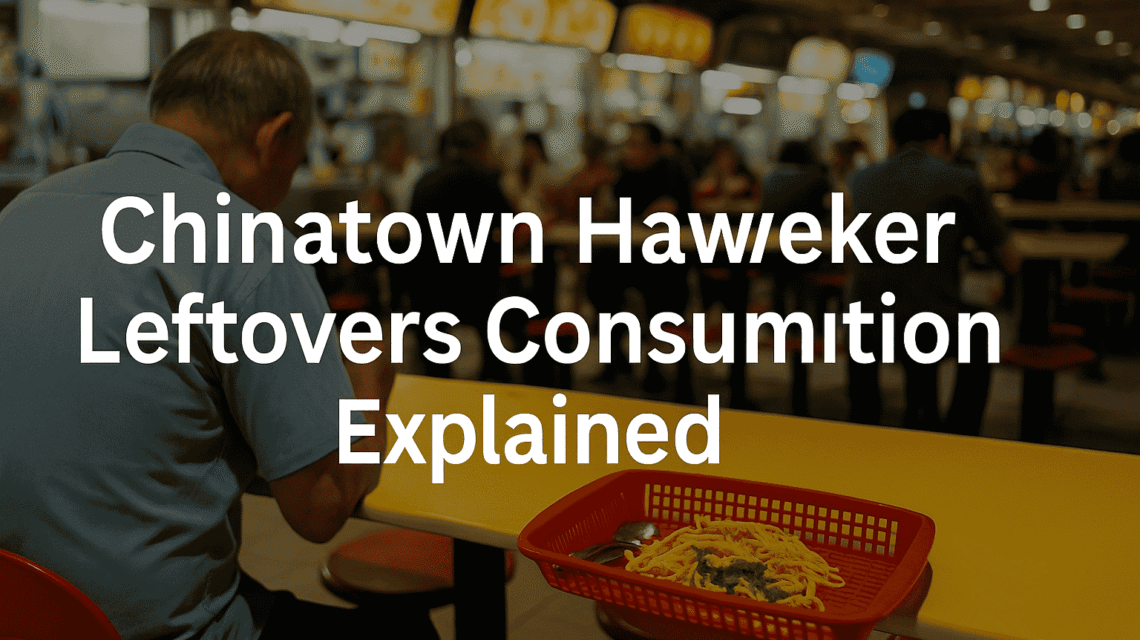In the heart of many Chinatowns across Asia and beyond, a unique practice is quietly shaping conversations around sustainability Chinatown hawker leftovers consumption. While some may view leftover food as waste, many locals and food-savvy visitors see it as a practical solution to reduce environmental impact and support low-income communities. This culturally rooted habit curbs food waste and highlights the ingenuity and resilience of hawker food culture. This article will explore how this practice works, its benefits, and how it compares to food reuse systems in the U.S.
The Cultural Significance of Leftover Consumption in Chinatown
Historical Context
In many Chinese communities, the philosophy of not wasting food is deeply ingrained. Traditionally, food represents prosperity, gratitude, and respect. Leaving food untouched or throwing it away was considered disrespectful, especially in households that had survived times of scarcity. This mindset extended into communal eating spaces like hawker centers, where even today, many elders encourage mindful consumption.
Modern-Day Practices
Today, Chinatown hawker centers remain a melting pot of culture and cuisine. Leftover consumption isn’t limited to patrons bringing home unfinished meals. Some vendors sell surplus food at discounted rates toward the end of the day. Locals often make it a habit to revisit these stalls in the evening, ensuring savings and sustenance. It’s common to see food-sharing practices where unsold meals are collected for charities or redistributed via community fridges.
Environmental and Economic Impacts
Reducing Food Waste
Food waste is a mounting global crisis. According to the Food and Agriculture Organization (FAO), approximately one-third of all food produced is wasted. Chinatown hawker leftover consumption serves as a microcosm of what responsible food behavior can look like. By minimizing waste through conscious consumption and redistribution, the environmental burden of food production—from resource use to greenhouse gas emissions—is significantly reduced.
Economic Benefits for Vendors and Consumers
Hawker vendors operate on thin margins. The ability to sell leftover food at a reduced cost helps vendors recoup losses and opens doors to consumers who may otherwise find full-price meals out of budget. It’s a win-win model: vendors reduce waste while expanding their customer base, giving consumers affordable, delicious food.
Health and Safety Considerations
Food Safety Protocols
A common concern regarding leftover consumption is food safety. Fortunately, many hawker centers like Singapore have stringent food hygiene regulations. Vendors often label repackaged leftovers with date and time stamps. Food is stored at safe temperatures, appropriately reheated, and regularly inspected by health authorities. These practices ensure that even discounted meals maintain high safety standards.
Addressing Public Concerns
Despite these precautions, the stigma around eating leftovers persists. Some associate it with poverty or poor hygiene. Education and awareness are key to shifting this perception. By highlighting the safeguards in place and the cultural reverence for not wasting food, public sentiment can slowly change toward embracing leftover consumption as an innovative and sustainable choice.
Innovative Approaches to Leftover Management
Technological Solutions
Technology is increasingly playing a role in minimizing food waste. Mobile apps now connect consumers with vendors offering discounted meals close to closing. Platforms like OLIO and Treatsure (in Singapore) help redistribute surplus food, ensuring it doesn’t end up in landfills. Chinatown hawker centers are slowly adopting these innovations, integrating digital tools with traditional food culture.
Community Initiatives
Beyond technology, grassroots movements are gaining traction. Local non-profits collaborate with hawker stalls to collect unsold food for underprivileged groups. Community fridges, often located near housing blocks, are stocked with untouched leftovers for anyone in need. These initiatives not only curb waste but also strengthen community ties.
Global Perspectives and Comparisons
Practices in Other Cultures
Chinatown’s approach isn’t unique. In Japan, “mottainai” captures a similar spirit of not wasting what’s valuable. In South Korea, food waste recycling is strictly regulated. Western countries are also catching up, with supermarkets in France legally required to donate unsold food. Comparing these systems helps contextualize Chinatown’s practices within a global movement toward food sustainability.
Potential for Broader Adoption
Can Chinatown’s leftover consumption model work elsewhere? Absolutely—with adaptations. It requires cultural acceptance, regulatory support, and community participation. By framing leftover consumption as environmentally responsible and socially rewarding, cities worldwide can learn from Chinatown’s nuanced approach.
Conclusion
Consuming leftovers at Chinatown hawkers is more than a quirky local practice. It’s a blueprint for sustainable, respectful, and economically beneficial food behavior. As we face a mounting food waste crisis, embracing such models can lead us toward a more conscious and connected future.
FAQs
Is it safe to eat leftover food from hawker centers?
Yes, food safety standards are strictly enforced in regulated environments like Singapore. Leftovers are stored and handled with care to ensure safety.
Why do hawker centers sell leftover food?
Selling leftovers reduces food waste and helps vendors recover operational costs while offering affordable food to the public.
How does leftover consumption help the environment?
It reduces the amount of food going to landfills, conserves resources used in food production, and lowers greenhouse gas emissions.
Can leftover consumption become a trend in the US?
With growing awareness around sustainability and food waste, practices similar to those in Chinatown can gain traction in the US, especially in urban centers.
Are there apps in the US for leftover food sharing?
Yes. Apps like Too Good To Go, OLIO and Food Rescue US connect consumers with surplus food from restaurants and vendors.
Is it safe to eat leftover food from hawker centers?
Why do hawker centers sell leftover food?
How does leftover consumption help the environment?
Can leftover consumption become a trend in the US?
Are there apps in the US for leftover food sharing?

